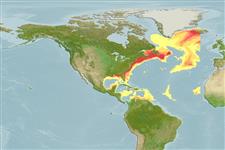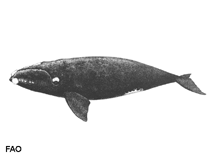Eubalaena glacialis (Müller, 1776)
North Atlantic right whale| Native range | All suitable habitat | Point map | Year 2050 |

|
| This map was computer-generated and has not yet been reviewed. |
| Eubalaena glacialis AquaMaps Data sources: GBIF OBIS |
Classification / Names ชื่อสามัญ | ชื่อพ้อง | CoL | ITIS | WoRMS
Mammalia | Cetartiodactyla | Balaenidae
Environment: milieu / climate zone / ระดับความลึก / distribution range นิเวศวิทยา
ผิวน้ำ; สัตว์น้ำที่อาศัยและอพยพภายในทะเลเท่านั้น (อ้างอิง 75906); ระดับความลึก 0 - 16 m (อ้างอิง 116169). Temperate; 90°N - 90°S, 180°W - 180°E
Distribution ประเทศต่างๆ | พื้นที่จำแนกตาม FAO | ระบบนิเวศหลายระบบ | การปรากฏขึ้น,การเกิดขึ้น,พบ | การแนะนำ
North Atlantic: Balaena glacialis glacialis: Davis Strait, Denmark Strait, Norwegian Sea south to Massachusetts and the Bay of Biscay, south to Florida and the Golfo de Cintra, Western Sahara, Gulf of Mexico, Sea of Okhotsk, southern Bering Sea, northern Gulf of Alaska, south to the Sea of Japan, Pacific coast of northern Honshu and the coast of central California, Taiwan, Baja California Sur, Hawaiian Islands; Balaena glacialis australis: Subantarctic zone, between 35° to 40°S and 55° to 60°S, southern Brazil to northern Argentina, Tristan da Cunha, Namibia, southern Mozambique to Cape Province, St Paul Island, Southwest and southeast Australia, Kermadec Island, central Chile (Ref. 1522). Temperate, subpolar.
Length at first maturity / ขนาด / Weight / Age
วัยเจริญพันธุ์: Lm ?, range 1,250 - 1550 cm Max length : 1,800 cm TL เพศผู้/กระเทย; (อ้างอิง 1394); น้ำหนักสูงสุดที่มีการรายงาน: 100.0 t (อ้างอิง 1394)
Short description สัณฐานวิทยา
Life cycle and mating behavior วัยเจริญพันธุ์ | การสืบพันธุ์ | การวางไข่ | Eggs | ความดกของไข่ | Larvae
Main reference
อ้างอิง | ผู้ประสานงาน | ผู้ร่วมมือ
Jefferson, T.A., S. Leatherwood and M.A. Webber 1993 FAO species Identification Guide: Marine Mammals of the World. Rome, FAO. 320 p. + 587 figures. (อ้างอิง 1394)
IUCN Red List Status
(อ้างอิง 130435: Version 2025-1)
CITES status (อ้างอิง 108899)
CMS (อ้างอิง 116361)
Threat to humans
Human uses
การประมง: เน้นการพาณิชย์
FAO - การประมง: landings, species profile | FishSource | ทะเลรอบๆเรา
เครื่องมือ
ข้อมูลเพิ่มเติม
Max. ages / sizes
Length-weight rel.
Length-length rel.
Length-frequencies
Mass conversion
อุดมสมบรูณ์
แหล่งที่มาจากอินเตอร์เน็ต
BHL | BOLD Systems | CISTI | DiscoverLife | FAO(การประมง: species profile; publication : search) | Fishipedia | GenBank (genome, nucleotide) | GloBI | Gomexsi | Google Books | Google Scholar | Google | PubMed | แผนภูมิชีวิตแบบต้นไม้ | Wikipedia (Go, ค้นหา) | บันทึกทางด้านสัตววิทยา



